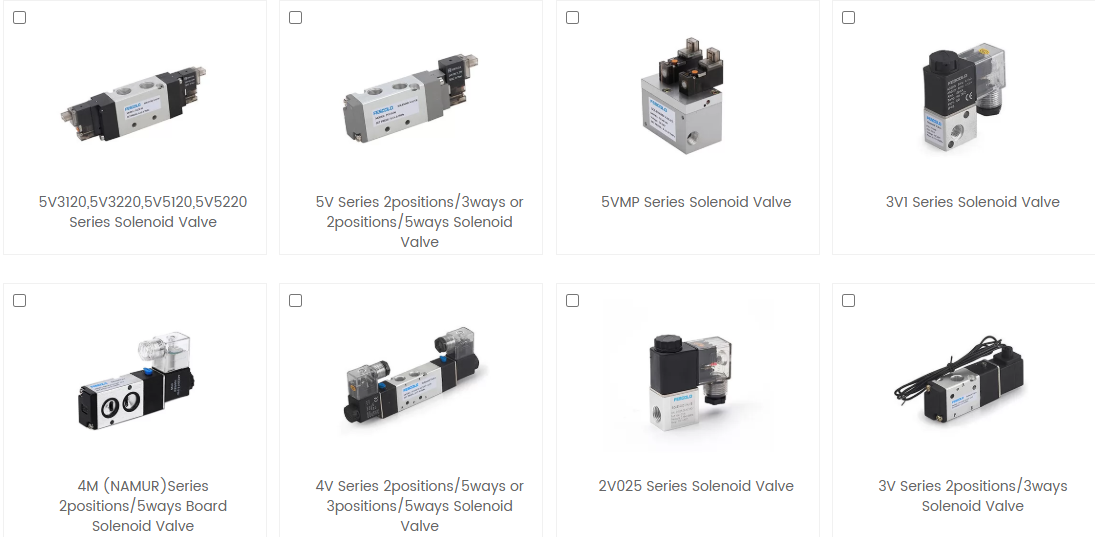Introduce
Selecting the correct valve actuator in today's modern industry can greatly affect the efficiency and performance of a system. Why pneumatic solenoid valve is becoming increasingly popular in various industries is due to its structural characteristics, advantages, and wide range of application industries.Pneumatic solenoid valves are serving as the most essential pneumatic directional component in industrial automation control
Pneumatic solenoid valve is also a kind of solenoid valve,features of fast response, compact structure, easy control, and strong adaptability.It is widely used in industries such as automation equipment, mechanical manufacturing, packaging, textiles, automobiles, food, electronics, and chemicals. pneumatic operated solenoid valve is indispensable control core components in modern industrial pneumatic systems.
What is pneumatic solenoid valve?
Pneumatic solenoid valve controls the on/off and flow direction of compressed air through electrical signals, thereby driving pneumatic actuators.However, a pneumatic solenoid valve still falls under the category of electromagnetically controlled valves; it is not pneumatically controlled. In fact, it is precisely controlled by an electromagnetic mechanism to regulate the flow of compressed air.
Pneumatic solenoid valve combines electrical signals with pneumatic fluids control, used to control the on/off and flow direction of compressed air. Solenoid pneumatic valve has the characteristics of fast response, compact structure, easy control, and strong adaptability. They are widely used in industries such as automation equipment, mechanical manufacturing, packaging, textiles, automobiles, food, electronics, and chemicals. Pneumatic solenoid valve is one of essential control core components in modern industrial pneumatic systems.
The advantages of pneumatic solenoid valve
Pneumatic solenoid valve enables multi-port directional control and is specifically used to drive pneumatic actuators.Other advantages as follows:
Fast response: Due to its electronic control, air solenoid valve can instantly control the airflow when powered on.
Simple control: No need for manual labor, air operated solenoid valve driven by electrical signals, easy to integrate with PLC and other systems.
Low energy consumption: only powered on at the moment of commutation.
Compact structure: Air solenoid valve's structural design is compact and suitable for miniaturized equipment.
Easy maintenance: adopting standardized interfaces, pneumatic solenoid valve is easy to replace and repair.
Pneumatic solenoid valve is a very good ideal for complex media direction control and actuator motion control.
Pneumatic solenoid valve features
◆ Combination of electronic control and pneumatic compressed air source drive.
◆ There are various types such as single electronic control and dual electronic control.
◆ Multiple ports/ways and positions forms.
◆ Can be integrated on the compressed air control island for centralized management.
The function of pneumatic solenoid valve
◆ Control the on/off and direction change of gas.
◆ Drive the actions of cylinders, pneumatic claws, pneumatic actuators, etc.
◆ Implement automated operations such as sequential control, logical control, interlocking control, etc.
Types of pneumatic solenoid valve
Whether a pneumatic solenoid valve is used solely for controlling compressed air or for mixed media applications including water, oil, and steam, it can adopt either of two actuation methods: direct-acting or pilot-operated. These two methods differ in both structure and application.

Can be controlled by the number of ways and positions
2 ways pneumatic solenoid valve include:2-way is the simplest control type of air solenoid valve, used only to control the on and off of compressed air.
3 ways pneumatic solenoid valve include:A typical 3/2 air solenoid valve has one inlet port, one exhaust port, and one outlet port. It comes in normally open and normally closed configurations, is usually single-coil controlled, features a compact structure, and is mostly pilot-operated.
4 ways pneumatic solenoid valve include:The main type is a 4-way 2-position compressed air solenoid valve, with one inlet port, one exhaust port, two working ports, and two operating positions. There are also 4-way 3-position pneumatic solenoid valves with three operating positions.
5 ways pneumatic solenoid valve include:The main type is the 5-way 2-position air solenoid valve, but there are also 5-way 3-position types. Both have one inlet port, two working ports, and two exhaust ports, allowing airflow switching. They are generally used to control double-acting cylinders.
Classified by work status
2-position valve
3-position valve
Normally Open
Normally Closed
Classified by the number of electromagnetic heads
Pneumatic single solenoid valve:Only one solenoid coil operates, and when power is off, it resets by a spring.
Double pneumatic solenoid valve:When two solenoid coils operate, the valve maintains its switched position and does not automatically reset.
Classified by brands
Festo:High precision, modularity, intelligent control, and industrial automation,suitable for high-end manufacturing industries such as automotive and electronics.
SMC:Compact design, high cost-performance ratio, and strong versatility,ideal for automation equipment and general industrial applications.
Asco:Industrial-grade practicality, high reliability, explosion-proof, corrosion-resistant, and large flow capacity,well-suited for petrochemical, energy, and fluid control industries.
Classified by driven methods
Direct-acting:The solenoid coil directly controls the valve core to open or close the air passage.
Pilot-operated:The main valve core is driven by air pressure to switch the main airflow direction, requiring a minimum operating pressure.
Servo-assisted:Compared to purely direct-acting valves, it saves solenoid coil power; compared to purely pilot-operated valves, it can start at lower pressure.
The application of pneumatic solenoid control valve
The design of pneumatic soleoid valve is specifically designed for controlling compressed air media, and the following are industries that extensively use compressed air as a power source
Industrial manufacturing automation: assembly lines, robotic arms.
Control packaging equipment: sealing, packaging, labeling, etc.
Automotive manufacturing: welding, conveying, testing equipment.
Food and beverage: automatic filling, coding, and handling.
Electronic manufacturing: SMT surface mount, testing equipment.
Pneumatic vs solenoid valve
Pneumatic solenoid valve, as a actively electrically control valve equipped with a solenoid coil.what is difference between pneumatic and solenoid valve?
| Pneumatic Valve | solenoid valve |
Control method
| Pneumatic signal control | Electrical signal control |
| Driving Energy | Compressed Air source
| Electromagnetic force |
| Power Supply Required | Not required | required |
| Response Speed | Slower | Fast
|
| Application Environment | explosion-proof, high-temperature, or non-electric. | Requires power, ideal for automated electrical systems |
| Structural Complexity | Relatively complex | Compact structure |


















